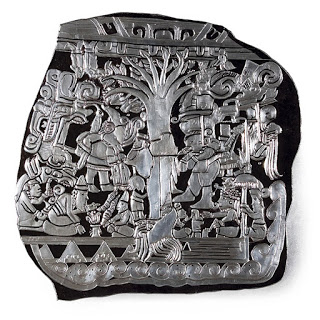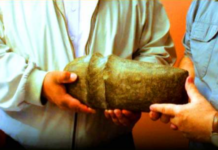
On this blog I have been showing you a lot of archaeological artifacts of items found in North America, some with a tie to the Hebrew language. I want to be clear with my readers. Just because I post it on this blog doesn’t mean it is authentic. I share information to expand our desire to view all things that have been found and validate them by means of study and prayer. As Moroni said, “we may know the truth of all things.”
I love what Elder Holland said. “Truly rock-ribbed faith and uncompromised conviction comes with its most complete power when it engages our head as well as our heart… Truth borne by the Holy Spirit comes with, in effect, two manifestations, two witnesses if you will—the force of fact as well as the force of feeling… I believe God intends us to find and use the evidence He has given—reasons, if you will—which affirm the truthfulness of His work… Evidence is still evidence even if it is not immediately observable…” The Greatness of the Evidence By Elder Jeffrey R. Holland August 16, 2017
The Spirit of truth can be physical and spiritual. I feel strongly that this land of the United States is the Promised Land spoken of in the Book of Mormon and this book is the Word of God. Because of that, I believe we will find secondary evidences to assist us if needed. I have seen many in the Church who don’t have a strong witness of the Spirit that have found a new hope in physical evidence of the Book of Mormon as a real history of a real people. I have a friend that has struggled with a testimony, but as soon as I discussed the Moundbuilders, an actual real people of history, he began researching and found his knowledge about these Moundbuilders to spark a renewed desire to read and pray again about the Book of Mormon.
I am just a typical Saint trying hard to share information whether physical or spiritual that I feel will help each of you study and pray on your own to strengthen your own testimony of the Lord Jesus Christ.
If you haven’t read Jonathan Neville’s book titled “Mesomania” it is a great read. As I read it today I remember back to that zeal I had for 40 years about the Mesoamerican Theory. That zeal is now heavily focused in the Heartland and I am blessed to know this great country is indeed the place spoken of in the Book of Mormon.
Blog by Jonathan Neville Visit Here
The Mesomania book is available by clicking on the picture below..
By way of explanation, I’m not criticizing any current LDS scholars. I fully respect their efforts and deeply appreciate the good work they’ve done in many fields. Plus, they’re great people. I just think they’re making a fundamental mistake about the geography question and I’m just trying to understand the psychology behind the Mesoamerican theory. It’s a fascinating topic, and I have a much longer manuscript, but everyone wants short books, so I made the Mesomania as short as I could.
For those new to this blog, I don’t care what anyone thinks about Book of Mormon geography and historicity so long as it works for them and gets them to read the text and incorporate the teachings.
However, it seems obvious that the vast majority of the people in the world reject the Book of Mormon as a legitimate, authentic history. This includes members of the Church, too many of whom are inactive. Even among active members, many don’t think the Book of Mormon is an authentic history. I do.
And I think the Mesoamerican theory is a distraction that deters people from accepting the Book of Mormon as an authentic history. Of course, there are some people who find great value in seeing Mesoamerican culture in the text. That’s fine. As I said, whatever works. You can apply the scriptures to yourselves by reading into the text attributes of African culture, Chilean culture, etc.
But when the scholars present only the Mesoamerican theory to their students (or, just as bad, an abstract map theory), and seek to present only that theory to the world through missionary work, in my view it’s a serious mistake because, as Joseph Fielding Smith warned, the theory causes members (and investigators) to become confused and disturbed in their faith in the Book of Mormon.
I think the Mesoamerican distraction originated with Benjamin Winchester, William Smith and others in the 1840s, but it died down until the 1920s when the limited geography setting in Mesoamerica was developed by RLDS scholars. They were the first to reject the New York Cumorah; so far as I can discover, not a single person who knew Joseph rejected the New York Cumorah.
LDS scholars at BYU gradually adopted the RLDS position over the objection of Joseph Fielding Smith, and that’s where we are today.
I’m hoping we can change course, embrace Letter VII and the other early teachings, and become united as LDS who have full faith in the historicity of the Book of Mormon.
__________________
In Mesomannia, I explain my views on the psychology that drives the effort by modern LDS scholars to promote the Mesoamerican theory. Among other things, they are seeking to accomplish these objectives:
1. Reject Letter VII by characterizing Oliver Cowdery as a speculative, unreliable man who lacks credibility.
2. Reject David Whitmer’s accounts because he, too, was a speculative, unreliable man who lacks credibility.
3. Portray Joseph Smith as an uncertain man who 1) embraced a false tradition about the Hill Cumorah in New York and 2) changed his mind about the North American setting and embraced a Mesoamerican setting with the expectation that modern LDS scholars would answer the questions about Book of Mormon geography.
________________
For me, those objectives undermine faith and are the fulfillment of Joseph Fielding Smith’s warning.
And it’s all so unnecessary.
Which is why I want to understand the psychology, and why I wrote Mesomania.
Critics of the Book of Mormon point to the lack of physical evidence to corroborate the narrative in the text, but the real problem is choosing among the abundant evidences. Almost no matter where you look in the Americas, scientists are uncovering more and more physical evidence of ancient civilizations that expands our understanding and appreciation of these cultures. These civilizations were more extensive and more sophisticated than previous generations realized.
But that’s a topic for another day.
Here, I want to address the challenge of zeal. Advocates of most theories of Book of Mormon geography have a certain degree of zeal or they wouldn’t be advocates. Nothing wrong with zeal, per se. You need zeal to accomplish anything. But you can also have excessive zeal, and we want to be cognizant of that so we don’t make counterproductive mistakes.

At the same time, we don’t want to dismiss a proposed setting just because some advocates have emphasized artifacts that turn out not to be what they were once thought to be, or are represented to be. That’s just as irrational as relying on the artifacts in the first place.
______________________________
In the area of Book of Mormon archaeology, probably the best-known mistake is Izapa Stela 5, the so-called “Lehi’s Tree of Life” stone. For decades, it was promoted as proof that the Book of Mormon took place in Mesoamerica.
The Church even got involved. An article in the 1985 Ensign evaluates Stela 5 and says, “If this is true—and, again, we must remain cautious and tentative until all the evidence is in—Stela 5 may prove to be the first deciphered artifact from the Nephite civilization.”
That’s some powerful hype.
Stela 5 was again on display in the Liahona magazine in 2010.

There’s a replica of Stela 5 on display at the Utah Cultural Center. For years, you could buy replicas at Deseret Book and the BYU bookstore. I’ve seen them in the homes of many Latter-day Saints. I’ve seen replicas in offices. Stela 5 has become the emblem of the Mesoamerican theory for many people.
Even the wikipedia article on Stela 5 comments on this:
“Based on parallels with traditions originating in the Old World, a few researchers have linked the stone to theories of pre-Columbian trans-oceanic contact. Mormon theorist M. Wells Jakeman proposed that the image was a representation of a tree of life vision found in the Book of Mormon.[11] Jakeman’s theory was popular for a time among Mormons, but found little support from Mormon apologists.[12] Julia Guernsey finds that Jakeman’s research “belies an obvious religious agenda that ignored Izapa Stela 5’s heritage”.[13]“
In fact, I have an article from 2004 titled “Izapa Stela 5: Deception in Stone” by Kathryn Egan that demonstrates the stone has nothing to do with the Book of Mormon, but the myth persisted anyway.
I think it’s fair to say now that the link between Stela 5 and the Book of Mormon has been largely abandoned by LDS scholars, including those who otherwise believe the Mesoamerican setting. I attended a seminar last year when this was announced and the audience seemed upset and disappointed. Nevertheless, the connection persists in LDS culture. Just google “Stela 5” and you’ll find lots of examples.
Does this example of poor evidence invalidate the Mesoamerican theory? Of course not. We should recognize people make mistakes. Research continues throughout the Americas.
_____________________
Historical note. The first “proof” artifact from South America was brought to Nauvoo in 1842. These were paper facsimiles taken from a 20-foot long hieroglyphic engraving on a rock in South America. It purported to show Lehi crossing the “large waters” before landing on this continent, as well as their travels and encampments. They were presented to Joseph Smith. If you have never heard about this, it’s because Joseph didn’t give it any credence. Just like we shouldn’t give any credence to physical evidence that doesn’t add up.
_____________________
There is unreliable physical evidence everywhere we look, both because of fakes and because of illusory “correspondences” that we hope will validate our expectations.
I’m hoping we can all work together to support evidence that corroborates the Book of Mormon wherever it is found.
Source: Book of Mormon Wars





